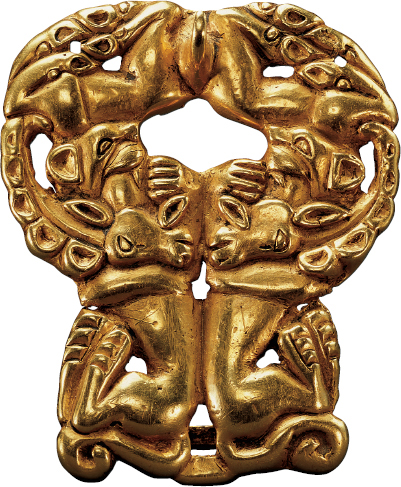Inner Asia and the Silk Road
The difficulty of defending against the nomadic pastoral peoples to the north in the region known as Inner Asia is a major reason China came to favor a centralized bureaucratic form of government. Resources from the entire subcontinent were needed to maintain control of the northern border.
Chinese civilization did not spread easily to the grasslands north of China proper because those lands were too dry and cold to make good farmland. Herding sheep, horses, camels, and other animals made better economic use of those lands. By the third century B.C.E. several different peoples practicing nomadic pastoralism lived in those regions. Chinese farmers and Inner Asian herders had such different modes of life that it is not surprising that they had little respect for each other. For most of the imperial period, Chinese farmers looked on the northern non-
In the late third century B.C.E. the Xiongnu (possibly the same group that was known in the West as the Huns) formed the first great confederation of nomadic tribes (see Map 7.1). The Qin’s Great Wall was built to defend against the Xiongnu, and the Qin sent out huge armies in pursuit of them. The early Han emperors tried to make peace with them, offering generous gifts of silk, rice, cash, and even imperial princesses as brides. Xiongnu power did not wane, and in 166 B.C.E. 140,000 Xiongnu raided to within a hundred miles of the Chinese capital.

Emperor Wu then decided that China had to push the Xiongnu back. He sent several enormous armies deep into Xiongnu territory. These costly campaigns were of limited value because the Xiongnu were a moving target. If the Xiongnu did not want to fight the Chinese troops, they simply moved their camps. To try to find allies and horses, Emperor Wu turned his attention west, toward Central Asia. From an envoy he sent into Bactria, Parthia, and Ferghana in 139 B.C.E., the Chinese learned for the first time of other civilized states comparable to China.
In 114 B.C.E. Emperor Wu sent an army into Ferghana and gained recognition of Chinese overlordship in the area, thus obtaining control over the trade routes across Central Asia commonly called the Silk Road (see Map 7.1). The city-
At the same time, Emperor Wu sent troops into northern Korea to establish military districts that would flank the Xiongnu on their eastern border. By 111 B.C.E. the Han government also had extended its rule south into Nam Viet, which extended from south China into what is now northern Vietnam.
During the Han Dynasty, China developed a tributary system to regulate contact with foreign powers. States and tribes beyond its borders sent envoys bearing gifts and received gifts in return. Over the course of the dynasty, the Han government’s outlay on these gifts was huge, perhaps as much as 10 percent of state revenue. Although the tributary system was a financial burden to the Chinese, it reduced the cost of defense and offered China confirmation that it was the center of the civilized world.
Silk given to the Xiongnu and other northern tributaries as part of the tributary system often entered the trading networks of Persian, Parthian, and Indian merchants, who carried it by caravans across Asia. There was a market both for skeins of silk thread and for silk cloth woven in Chinese or Syrian workshops. Caravans returning to China carried gold, horses, and occasionally handicrafts of West Asian origin, such as glass beads and cups. Through the trade along the Silk Road, the Chinese learned of new foodstuffs, including walnuts, pomegranates, sesame, and coriander, all of which came to be grown in China.
Maintaining a military presence so far from the center of China was expensive. To cut costs, the government set up self-